思いがけず拝見できました(愛知県名古屋市千種区姫池通 骨董買取 古美術風光舎)
2024.03.10
皆さまこんにちは。スタッフHでございます。
本日は名古屋ウイメンズマラソンが開催されており、風光舎近くの道路にも迂回案内の警備の人の姿が見えます。最近はお洒落なウエアに身を包み颯爽と走っている女性をよく見かけます。かっこいいなぁとただ眺めております。
先日、通りすがりに迫力のある展覧会のポスターに出くわし、いつもの如く予定を少し変更しての鑑賞となりました。江戸時代初期の修験僧であり、諸国を行脚し数多くの仏像を彫った仏師でもある「円空」の作品展でした。
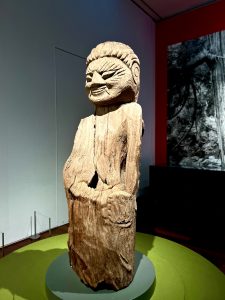
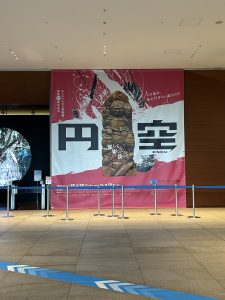
以前、円空の特集番組で名古屋市内の荒子観音寺にて毎月第二土曜日に「円空仏」を拝見できると知りました。いつか実物を拝みたいと思っておりましたが、思いがけず拝見する機会に恵まれました。撮影可能な作品もあり、いくつか写真に収めさせていただきました。
入り口で迎えてくれたのは高さ2メートルを超える金剛力士(仁王)立像の吽形。普通は睨みをきかせているはずですが、こちらは口元が微笑んでいるようにも見えます。
岐阜県千光寺の境内に並んで根を張っていた2本のセンノキに梯子をかけ、阿吽(あうん)二体の金剛力士像を彫ったとされています。しばらくの間、そのまま山中にありましたが、150年ほど前に根が腐朽したため切り取られ、現在は「円空寺宝館」に安置されているとのことです。展覧会では状態のよい吽形のみが展示されていました。
背中の木のこぶを見ると、まさに大木から抜け出てきたことが分かります。
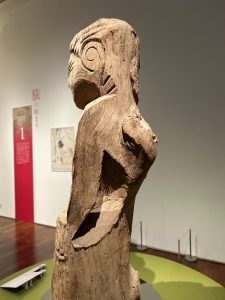
円空が自身の姿を彫ったとも伝えられる「賓頭盧尊者座像(びんずるそんじゃざぞう)」も拝見することができました。
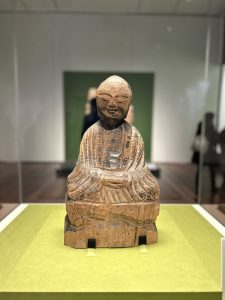
表面には永年撫でられてきたような艶があり、「撫で仏」として人々の願いを一心に受け止めてきたことでしょう。穏やかな佇まいに、思わず悩みを打ち明けすがってしまう気持ちがわかる気がいたします。
円空は1632年、美濃国で生まれたとされています。7歳で母親を亡くし若くして仏教の道に入ったとされていますが、詳しい経歴は分かっていないようです。どこの寺院にも所属せず、近畿地方、東北、北海道などを行脚しながら12万体ともいわれる仏像を残したとされており、現在5000体ほどが発見され「円空仏」と呼ばれています。山に籠り、厳しい荒行を続けながら、病や災害、干ばつに苦しむ人々を救うために念仏を唱えながら仏像を彫りました。
初期の頃の仏像は、表面が滑らかで丁寧に彫られていますが、次第にその土地で手に入る木を使い、節や切断面、彫ったノミの跡がそのまま残る簡素な仏像へと変化していきます。「観音三十三応現身像」のように、不揃いな板切れに目、鼻、口を線で彫っただけのものもあります。
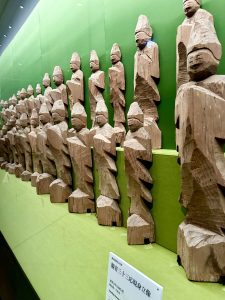
できるだけ多くの人々に届けたいとの願いもあったのでしょうが、円空自身、木の中には既に神や仏が宿っているので、余計なものを取り除いて取り出せばよいだけと考えていたようです。そのため木彫りの途中で出た小さな木っ端にも目や鼻をつけ仏を生み出しました。
円空仏の多くが微笑んでいるように見えるのには、幼い頃に死に別れた母親を追い求めているのではないかとも言われています。母親の33回忌に彫ったとされる十一面観音の体内から母親の形見の鏡などが発見されています。
いずれにしましても円空仏は長い時を超えて未だ私たちに安らいだ気持ちを与えてくれております。
荒子観音寺もまた訪れてみようと思います。
それでは、また次の機会に。
Hello everyone. This is Staff H.
The Nagoya Women’s Marathon is being held today, and I can see security guards on the road near the Fukosha to provide detour information. Recently, I often see women running dashingly in fashionable wear. I just look at them and think how cool they look.
The other day, I came across a poster for a powerful exhibition while passing by, and as usual, I had to change my plans a little to see the exhibition. It was an exhibition of works by Enku, a Buddhist monk of the early Edo period who traveled around the country and carved many Buddhist statues.
I had learned from a program featuring Enku that Enku Buddha can be viewed at Arako-Kannon-ji Temple in Nagoya City on the second Saturday of every month. I had hoped to someday see it in person, and I was unexpectedly blessed with the opportunity. Some of the works could be photographed, and I was able to capture some of them.
At the entrance, we were greeted by a standing statue of Kongorikishi (Nioh), Un-gyo, which stands over 2 meters tall. Normally, he would be glaring at us, but here his mouth looks as if he is smiling.
It is said that he carved the two statues of Kongorikishi (Nioh), A-Un and A-Un, by placing a ladder on two Sen-noki trees that were rooted side by side in the precincts of Senko-ji Temple in Gifu Prefecture. They remained in the mountain for a while, but about 150 years ago, the roots decayed, so they were cut down and are now enshrined in the Enkuji Treasure House. At the exhibition, only the “Un-gyou” was on display in good condition.
The wooden hump on its back shows that it has indeed emerged from a large tree.
We were also able to see the seated statue of Binzuruzonja, which is said to have been carved by Enku himself.
The surface of the statue has a sheen as if it has been stroked for many years, and as a “petting Buddha,” it must have received people’s wishes wholeheartedly. The calm appearance of the statue makes it easy to understand why people would unintentionally confide their worries and sympathize with the statue.
Enku was born in Mino Province in 1632, and is said to have entered Buddhism at a young age after the death of his mother at the age of seven, but the details of his life are not known. It is said that he left behind as many as 120,000 Buddhist statues while traveling around the Kinki region, Tohoku, and Hokkaido, without belonging to any temple. While holed up in the mountains and continuing his severe ascetic practices, he carved Buddhist statues while chanting the Buddhist prayer to save people suffering from diseases, disasters, and droughts.
Early Buddhist statues were carefully carved with smooth surfaces, but gradually they became simpler, using locally available wood with knots, cut surfaces, and chisel marks left by the carving process. Some, such as the “Kannon 33 Genshi-Zo,” are simply carved with lines for eyes, nose, and mouth on unevenly cut pieces of wood.
Although he may have wished to reach as many people as possible, Enku himself believed that the wood already contained deities and Buddhas, so all he had to do was to remove and take out the unnecessary ones. Therefore, even small pieces of wood from the wood-carving process were used to create the Buddha, with eyes and noses attached.
It is said that the smiling faces of many of Enku Buddha’s sculptures may be a reflection of the artist’s search for his mother, who died when he was very young. A mirror and other mementos of his mother have been found inside the body of the eleven-faced Kannon, which is said to have been carved on the 33rd anniversary of his mother’s death.
In any case, Enku-butsu still gives us a sense of peace and tranquility after such a long time.
I will visit Arako-Kannon Temple again.
See you next time.
*******************
ご実家の整理やお片付けなどをされている方のご相談などが多くございます。
お片付けなどくれぐれもご無理のないようになさってくださいませ。
風光舎では古美術品や骨董品の他にも絵画や宝石、趣味のお品など様々なジャンルのものを買取しております。
お片付けをされていて、こういうものでもいいのかしらと迷われているものでも、どうぞお気軽にご相談下さいませ。
また風光舎は、出張買取も強化しております。ご近所はもちろん、愛知県内、岐阜県、三重県その他の県へも出張いたします。
まずは、お電話お待ちしております。
愛知県名古屋市千種区姫池通
骨董 買取【古美術 風光舎 名古屋店】
TEL052(734)8444
10:00-18:00 OPEN
#骨董買取#古美術買取#出張買取#無料査定#生前整理#遺品整理#家じまい#実家じまい#掛け軸#絵画#木箱入り茶碗#刀剣#洋食器#貴金属

